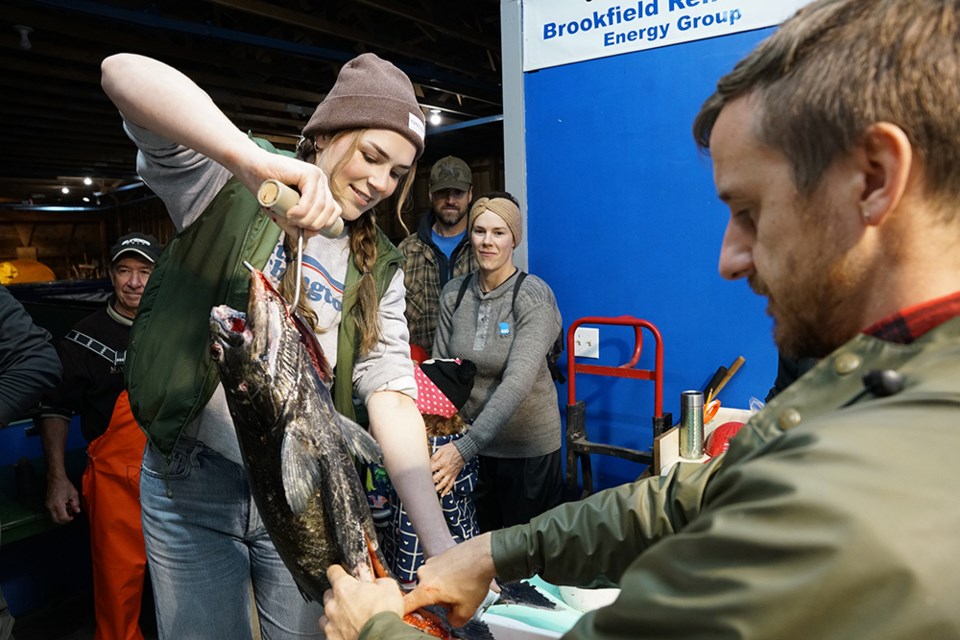While chinook salmon return numbers are down this year, an enthusiastic group of volunteers and staff gathered for the annual egg take for a local hatchery.
Powell River Salmon Society manager Shane Dobler said there was an excellent turnout for the chinook salmon egg take.
“Everybody comes back after the summer and gets back into the fishing spirit,” said Dobler. “They come with enthusiasm and it’s a measurement for our organization. It’s really important to have that. If we can’t get the attention of our community, we aren’t as successful as we are.”
This year, the hatchery had about 30 female chinook salmon. Dobler said that the salmon average 4,500 eggs apiece so that hatchery will have more than 100,000 chinook eggs, which is far less than the hatchery normally has.
Dobler said in a year where dry conditions have affected stream flows in other parts of the province, kudos goes to City of Powell River and Powell River Community Forest for their management of the environment.
“When you have the environment, you have fish,” said Dobler. “This year, the water in Haslam Lake was about an inch and a half lower than average. Interestingly, the water was a couple of degrees cooler at the bottom end.
“Every system is unique. With this system, the lower the water goes, the cooler the water gets. If we get rain, it actually warms up because we are getting more surface flow from Duck Lake.”
Dobler said the salmon society, and the fish, avoid crisis because of the great management of the watershed.
Dobler said that fish returns of the four species that spawn at Lang Creek vary from year to year. Chinook salmon returns are down this year.
“We are getting down into the range of worst years on record,” said Dobler. “However, it’s not uncommon to have off years. We had three huge years, then it tapered down. There are things that we don’t control. We can control the environment with good watershed management practices, but out on the ocean, those forces on our fish isn’t something that our organization influences one way or another.
“We would have to believe that some of our fish were caught, and particularly, with the way fisheries are closed early on, although not scientifically proven, we believe our fish are undergoing more scrutiny later on.”
Dobler said the salmon society wants to create that opportunity so that people can take their kids fishing. He said the society contributes to commercial fisheries, First Nations and sport.
“When we have less than we want, it’s out of our control,” said Dobler. “A combined pressure on the resource creates these lower returns.
“We will go to the Qualicum hatchery to see if they are able to get some chinook for us.”
Dobler said he is hoping for 200,000 eggs from the Vancouver Island hatchery.
Cameras monitor fish
Dobler said with smaller releases, there is smaller opportunity to catch, but the hatchery has been able to get good returns in the past from a smaller number of fish coming back to Lang Creek.
“When you lift up the hood, we have our challenges, but overall, our effort is pretty strong,” said Dobler.
He said pink salmon returns have been significant, even though some years have been minimal. He said that when there are great numbers of fish returning, fish rotting is good for a stream to a certain point, but the question is: how is that affecting other fish?
With chum salmon returns, over the last 10 years, there haven’t been any highs, which is strange, said Dobler. He said he hopes to see the numbers jump up again.
Dobler said the salmon society works hard to keep its finger on the pulse of the fish, with estuary observation to get a forecast of what they think is going to happen. He said the society also uses video cameras and technology to constantly monitor the fish.
Fisheries and Oceans Canada community advisory for the Sunshine Coast/qathet region Jim Wilson was in attendance at the egg take, working with the volunteers.
“I’ve been working on the Sunshine Coast for about 27 years,” said Wilson. “I’m spending time here with Powell River Salmon Society and Tla’amin Nation.”
Wilson said the egg take at the Powell River Salmon Society’s Lang Creek facility had gone well.
“A good volunteer group showed up,” said Wilson. “We’ve put in a request to Big Qualicum Hatchery, which is the original origin of the Lang Creek chinook. Hopefully, their run has been okay to good, and hopefully there will be a surplus over there so we can supplement the eggs here.”
Wilson said this is his favourite time of the year, dealing with fish.
Join the Peak's email list for the top headlines right in your inbox Monday to Friday.




